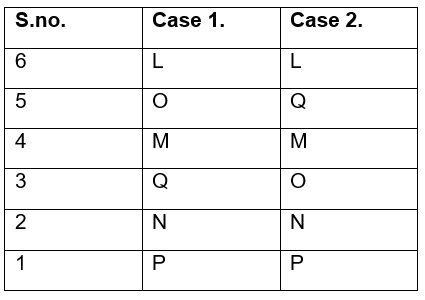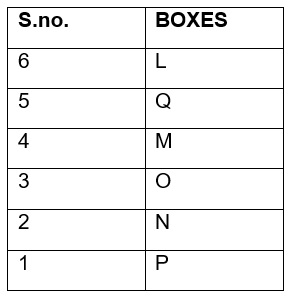Question
Six boxes, L, M, N, O, P and Q are one above the other,
such that the box which is at the bottom is numbered as 1, the box above it as 2 and so on. How many boxes are below Q? Statement I: There are three boxes between L and N. M is two boxes below L. O is above P. O is not the topmost box. Q is neither the topmost box nor the bottommost box. Statement II: P is two boxes below O. There are two boxes between L and O. L is above P. N is two boxes below M. The question given below consists of two statements I and II given below it. You have to decide whether the data provided in the statements are sufficient to answer the question. Read all the statements and give answer.Solution
From statement I, there are three boxes between L and N. M is two boxes below L. O is above P. O is not the topmost box. Q is neither the topmost box nor the bottommost box.  So, either two or four boxes are below Q. From statement II, P is two boxes below O. There are two boxes between L and O. L is above P. N is two boxes below M.
So, either two or four boxes are below Q. From statement II, P is two boxes below O. There are two boxes between L and O. L is above P. N is two boxes below M.  Four boxes are below Q. So, data in statement I alone is not sufficient to answer the question and data in statement II alone is sufficient to answer the question.
Four boxes are below Q. So, data in statement I alone is not sufficient to answer the question and data in statement II alone is sufficient to answer the question.
If the curved surface area and the radius of a cylinder are 550 cm2 and 7 cm, respectively, then find the volume (in cm3) of the c...
Two paths of width 6 metres are to be made in the centre of rectangular field such that they are perpendicular to each other. Find the area (in m2<...
The lengths of a pair of parallel sides of a trapezium are respectively 22 cm and 18 cm, and the perpendicular distance between these two sides is 15 cm...
A giant circular wheel has a diameter of 14 metres. In how many revolutions will the wheel cover a total of 16.5 km?
ABCD is a cyclic quadrilateral, such that ratio of measures ∠A, ∠B and ∠C is 1 : 4 : 5, then the measure of ∠D is.
- A right-angled triangle has its smallest median measuring 4.8 cm. Find the hypotenuse.
A race track is in the shape of a rectangle with length of 75 metres and area of 3000 m2. A car takes 20 seconds to make one lap around the p...
The lateral surface area of a cube is 196 cm2 . The length of a cuboid is 50% more than the side of the cube. The breadth of the cuboid is 3 ...
The area of four walls of a room is 144 cm2. If the length and breadth of the room were equal and the height of the room is 4 cm, then what i...
What is the measure of the radius of the circle that forms a triangle whose sides are 8 units, 15 units, and 17 units?
Relevant for Exams:



